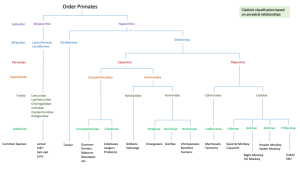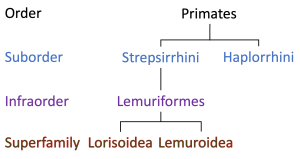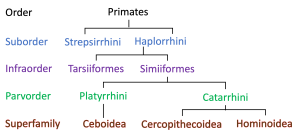Michelle Field

There are over 200 species and 600+ subspecies of primates living today. They vary in size from the tiny mouse lemur, weighing in at a whopping two ounces to the male silverback gorilla who can weigh over 400 pounds. Some are vegetarian while others are omnivores. Many live in tropical areas, but there is at least one species that lives in a temperate region where it snows. Some live exclusively in trees and others live exclusively on the ground. The diversity of primates is expressed in the classification system.
Two Systems of Classification
The traditional classification approach puts the primates into two suborders: Prosimii and Anthropoidea. The Prosimii contained lemurs, lorises, and tarsiers while anthropoidea consisted of monkeys and apes. The traditional classification approach used levels of taxonomic complexity to determine which suborder a primate should belong.
Most primatologists today use an approach that uses ancestral-descendant relationships to determine the suborder. In this biochemical evolutionary classification approach, there are also two suborders, but they are called Strepsirrhini, which includes lemurs, aye ayes, galagos, and lorises, and Haplorrhini, which includes tarsiers, monkeys, apes, and humans.

Strepsirrhini, which means “twist-nose,” characteristics include:
- snout-like nose
- wet rhinarium (hairless, moist area of skin on the snout–think dog nose)
- heightened sense of smell
- prominent whiskers
- divided upper lip tied to the gums by a membrane
- woolly fur
- grooming claw
- dental combs (tooth comb)
Most strepsirrhines are nocturnal and arboreal and have specialized features, such as large eyes with a light reflecting disk, to help with night vision. They were the first suborder of primates to evolve (O’Neil 1998-2012) and are sometimes referred to as the “lower primates.”

Haplorrhini, which means “simple nose,” characteristics include:
- relatively flattened faces (when compared to Strepsirrhini)
- forward facing eyes
- postorbital enclosure (bony plate encloses back of eye socket)
- dry noses
- decreased reliance on sense of smell
- larger brains and body size (when compared to Strepsirrhini)
- diastema (space between upper lateral incisor and upper canine tooth) except in humans
- increased gestation, maturation, and parental care
- more mutual grooming
References
Jurmain R, Kilgore L, Trevathan W. Essentials of physical anthropology, 4th edition. Belmont (CA): Wadsworth, Cengage Learning; 2013. 437 p.
Larsen CS. Our origins: discovering physical anthropology, 3rd edition. New York (NY): W.W Norton & Company, Inc.; 2014. 478 p.
O’Neill, D. 2014. The Primates [Internet]. San Marcos (CA): Palomar College; [cited 2015 Jun 22]. Available from: http://anthro.palomar.edu/primate/Default.htm
Suborder Strepsirhini [Internet]. c. 2001-2007. Edinburgh (Scotland): The Natural History Collections of the University of Edinburgh: [cited 2015 Jun 22]. Available from: http://www.nhc.ed.ac.uk/index.php?page=493.504.513
Cite this page
APA Style: Saneda, T. M. 2022. Modern primate taxonomy. In T. M. Saneda & M. Field, Biological Anthropology: a brief introduction. Cascadia College Pressbooks.
Chicago Style: Saneda, Tori M. 2022. “Modern Primate Taxonomy.” In Biological Anthropology: A Brief Introduction, 3rd. Bothell, WA: Cascadia College Pressbooks.
CSE Style: Saneda TM. 2010. Modern primate taxonomy. In: Biological Anthropology: a brief introduction, 3rd ed. Bothell (WA): Cascadia College Pressbooks. [modified 2022; accessed 2022 Dec 5]. https://openwa.pressbooks.pub/anth205bioanth/chapter/modern-primates.

